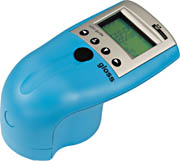Two in One Instrument provides combined color and gloss measurement.

Because of increasing quality requirements and the demand to secure a uniform appearance over time, automotive manufacturers perform extensive weathering studies on interior automotive components. The tests are often performed under extreme weather conditions, such as in the desert. Entire cars, system components or panels are exposed at outdoor "weathering stations." The weathered parts are periodically checked and compared to the "original," which the car manufacturer usually keeps in an environmentally controlled location.
To objectively determine changes in appearance, color and gloss must be controlled. Portable measuring devices allow the testing to be done outside at the test fences, which saves time since the parts can be tested on-site.
Up until now, two instruments were needed to measure color and gloss. The color-guide gloss from BYK-Gardner allows measurement of color and gloss simultaneously. In less than a second the hue of a color is checked using a sphere geometry in the specular included mode, and the 60øgloss is determined - at exactly the same spot and at the same time. Changes in appearance can now clearly be identified. The instrument gives reliable measurement results according to international specifications including the automotive guideline VDA 280.
The measured values are displayed in terms of delta L* (lightness change), delta a*/delta b* (hue change, yellowing), delta E* (total color difference) and the 60ø gloss value. In addition, any other color scale or index can be selected for display. The color-guide gloss allows users to save the color and gloss values of up to 200 standards (e.g., original values of master panels) and 999 samples (e.g., values of weathered parts).
The color-guide gloss uses light emitting diodes (LEDs) for illumination. This technology gives the following benefits.
- Long-term stable measurement results
- Long battery lifetime
- Ergonomic and robust design
The color-guide gloss is intuitive to use with its Microsoft Windows-like operation using pull-down menus. It comes with the software QC-link to transfer the measured data directly to EXCELTM for professional documentation.
For more information on testing instruments, contact BYK-Gardner USA, 9104 Guilford Road, Columbia, MD 21046; phone 800/343.7721 or 301/483.6500; fax 800/394.8215 or 301/483.6555.
Looking for a reprint of this article?
From high-res PDFs to custom plaques, order your copy today!




